Choosing a high-quality acoustic guitar on a budget can be a challenge because there are many to choose from and some are much better than others.
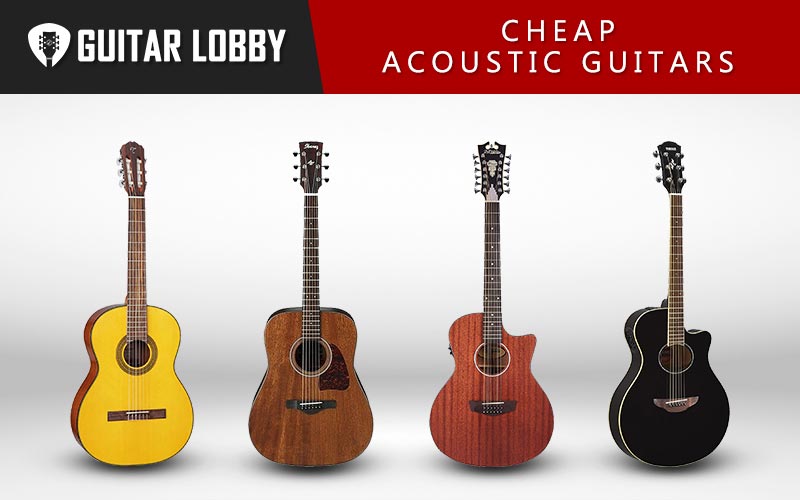
Also, there are a lot of different factors to consider, depending on your needs, apart from just the price, such as the reason for purchase, for instance. If you need to travel a lot and carry the instrument, then you must look for a smaller guitar, but then, you sacrifice the sound projection.
In this guide, I’m going to teach you how to choose the best cheap acoustic guitar for your needs, what factors to consider, and a whole lot more. I’ll start by jumping straight into reviews on my favorite models, but if you want to learn more about how to choose a guitar before reading reviews, check out our acoustic guitar buying guide at the bottom of the page.
| Name of Product | Image of Product | Description | Price Range | Full Review |
|---|---|---|---|---|
| 1. Yamaha APX600 (Best Overall) | 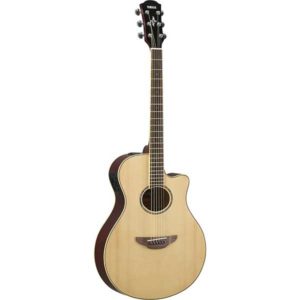 | Type: Acoustic-Electric Frets: 22 frets Strings: 6 strings | $300 | Read Full Review Below |
| 2. Cordoba Mini M (Best Mini) | 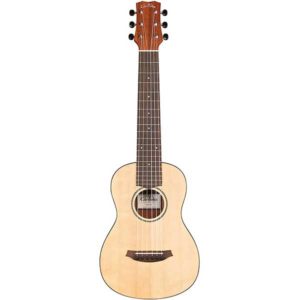 | Type: Mini Acoustic Frets: 18 frets Strings: 6 strings | $220 | Read Full Review Below |
| 3. Ibanez AW45 (Best Value) | 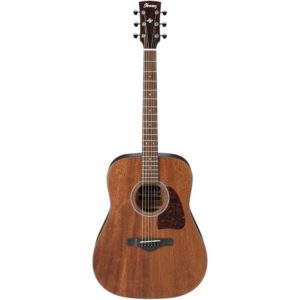 | Type: Acoustic Frets: 20 frets Strings: 6 strings | $230 | Read Full Review Below |
| 4. Takamine GC1 NAT (Best Classical) | 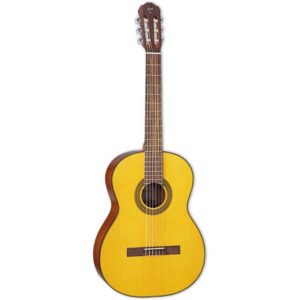 | Type: Acoustic Frets: 19 frets Strings: 6 strings | $230 | Read Full Review Below |
| 5. Luna Gypsy Grand Concert Acoustic-Electric Guitar | 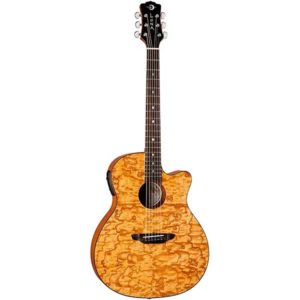 | Type: Acoustic-Electric Frets: 20 frets Strings: 6 strings | $270 | Read Full Review Below |
| 6. Traveler Guitar Ultra-Light Acoustic | 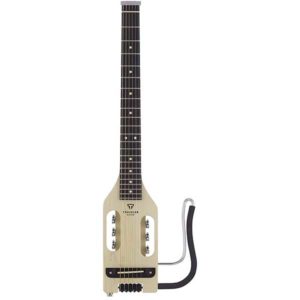 | Type: Travel Acoustic Frets: 22 frets Strings: 6 strings | $300 | Read Full Review Below |
| 7. Fender Alkaline Trio Malibu | 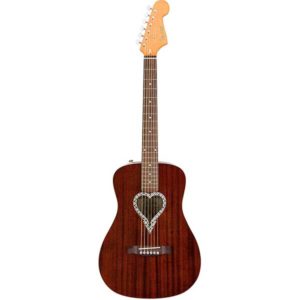 | Type: Acoustic Frets: 20 frets Strings: 6 strings | $300 | Read Full Review Below |
| 8. Epiphone DR-212 Dreadnought | 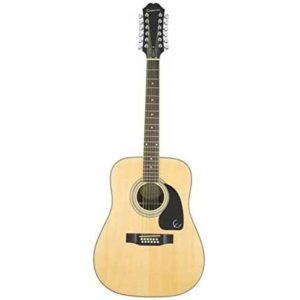 | Type: Acoustic Frets: 20 frets Strings: 12 strings | $270 | Read Full Review Below |
| 9. D’Angelico Premier Fulton LS (Best 12 String) | 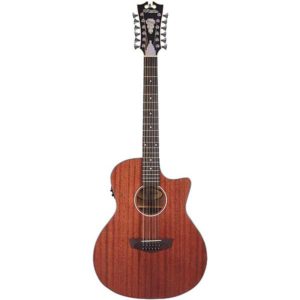 | Type: Acoustic Electric Frets: 20 frets Strings: 12 strings | $300 | Read Full Review Below |
| 10. Washburn Classical C40 Nylon String Acoustic Guitar | 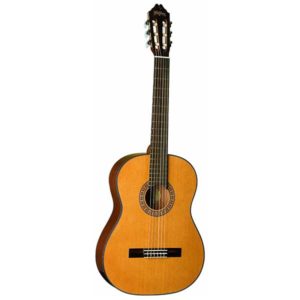 | Type: Acoustic Frets: 19 frets Strings: 6 strings | $190 | Read Full Review Below |
| 11. Mitchell Element Series ME1 Dreadnought | 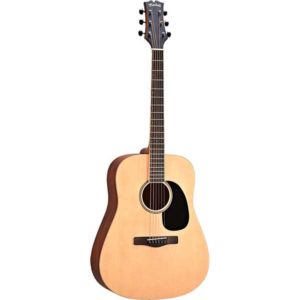 | Type: Acoustic Frets: 6 frets Strings: 20 strings | $250 | Read Full Review Below |
| 12. Recording King Dirty 30’s Series 7 RDS-7 Dreadnought (Budget Pick) | 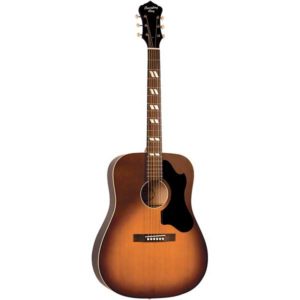 | Type: Acoustic Frets: 20 frets Strings: 6 strings | $170 | Read Full Review Below |
| 13. Rogue RA-090 Dreadnought 12-String | 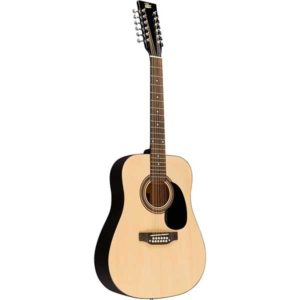 | Type: Acoustic Frets: 20 frets Strings: 12 strings | $170 | Read Full Review Below |
| 14. Daisy Rock Pixie | 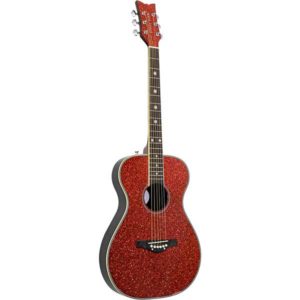 | Type: Acoustic Frets: 20 frets Strings: 6 strings | $200 | Read Full Review Below |
| 15. Rogue Starter Acoustic Guitar | 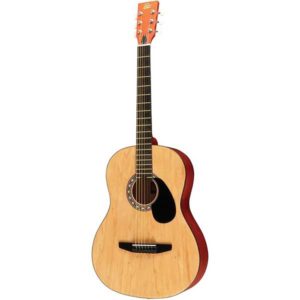 | Type: Acoustic Frets: 20 frets Strings: 6 strings | $80 | Read Full Review Below |
| 16. Jasmine S-34 Cutaway | 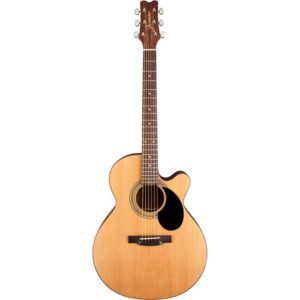 | Type: Acoustic Frets: 20 frets Strings: 6 strings | $120 | Read Full Review Below |
| 17. Washburn Apprentice G-Mini 5 | 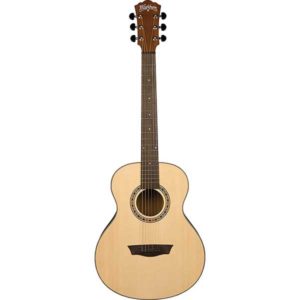 | Type: Acoustic Frets: 20 frets Strings: 6 strings | $200 | Read Full Review Below |
Here Are the Best Cheap Acoustic Guitars
1. Yamaha APX600 (Best Overall)
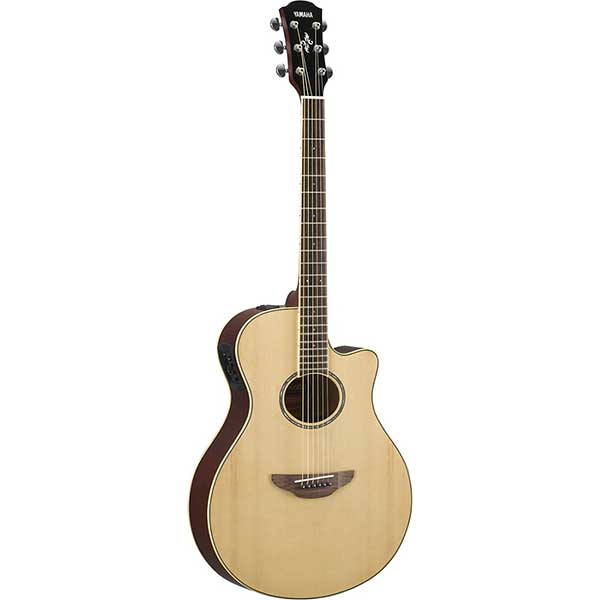
| Estimated Price | $300 |
| Top Material | Spruce |
| Back and Sides | Locally Sourced Tonewood |
| Finish | Gloss Body and Matte Neck Finish |
| Fret Count | 22 |
| Manufactured | Indonesia |
| Preamp | Yes |
My Review: If you’re familiar with Yamaha guitars then you probably already know Yamaha has a reputation for making some of the best guitars out there, and in my opinion, the APX600 is one of their best cheaper models. It’s masterfully crafted and has a surprisingly good build quality for a guitar at this price point, because of which it produces excellent tones, without any hick-ups. Thanks to the built-in tuner, as well as the System65A preamp, this model is capable of offering a great tonal experience. It comes with a plug-and-play design, which makes it very simple to set up and use, without having to bother with complicated settings. Apart from that, it is very comfortable to play, meaning that you will be able to play it for a prolonged amount of time. Overall, this is one of the truly amazing cheap acoustic guitars.
Key Specs and Features: Yamaha APX600 acoustic-electric guitar features a Thinline cutaway body, made of the top-quality spruce, allowing it to produce magnificent sound, while also being extremely comfortable. To further boost up the settings, there is a System 65A preamp piezo pickup, which allows you to amplify the sound the way you want it, and to customize your play experience. It will allow you to have more realistic tones, in the combination with the built-in tuner.
Build Materials: APX600 model is made of extremely well-balanced and top-quality materials. Its top is made of the Sitka spruce, which allows the instrument to have a higher resonance in tonality. Back, as well as the sides of the guitar, are made of tonewood, while the neck is built from the Nato wood. Bridge and fingerboard are both made of rosewood, with the nut and saddle that are built from urea.
Hardware: Yamaha APX600 features a total of 6 steel 0.012-0.053 strings, as well as 22 frets. The playing radius is 15.75”, while the scale length is 25”. As for the tuning machines, there is a die-cast chrome tuning machine, alongside the System 65A Preamp with Piezo Pickup, as well as a built-in tuner.
Finish: APX600 model features a pretty neat APX Thinline body, with elegant black color, as well as a beautiful gloss finish, and abalone rosette fingerboard.
Who Will Use This the Most: This guitar is very easy to set up, and it is quite comfortable to play, which makes it perfect for beginners, as well as for those who like to enjoy every moment of playing the instrument.
Bottom Line: Yamaha APX600 is a masterfully-crafted instrument, with an elegant look, as well as the capability to provide colorful, precise, and stable tones.
2. Cordoba Mini M (Best Mini)
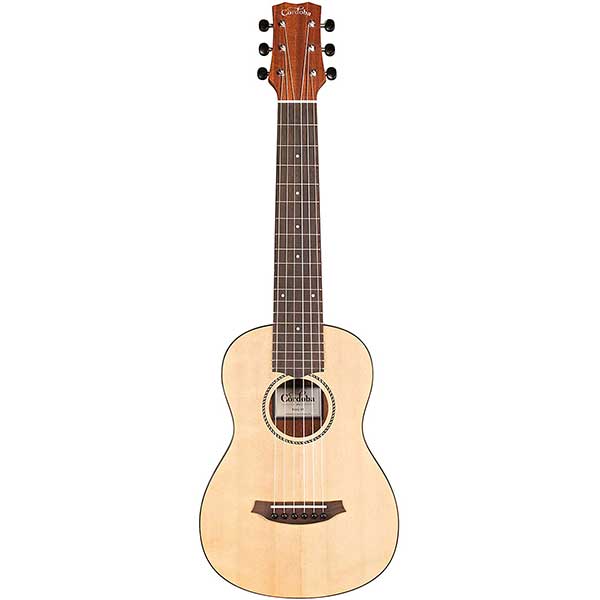
| Estimated Price | $220 |
| Top Material | Solid Spruce |
| Back and Sides | Mahogany |
| Finish | Satin finish |
| Fret Count | 18 frets |
| Manufactured | California, USA |
| Preamp | No |
My Review: If you are looking for a well-balanced and compact guitar for your travels, that is also affordable, then you are in the right place because Cordoba Mini M is the perfect choice for you. It is very compact and light, which makes it perfectly suitable for travelers. Because of its unique build and materials from which it was built, this guitar is capable of delivering beautiful tones. It comes with a mahogany neck that is 1.96” wide, which will give you the same feeling as if you were playing a larger guitar. What I really liked about this guitar is a nice detail in the form of bone nut and saddle, giving the instrument a very nice look.
Key Specs and Features: Cordoba Mini M is a compact acoustic guitar that is perfect for traveling, due to its smaller body. Alongside that, there is a full-sized neck, making it more comfortable to play. Next to that, this guitar features a 1.96” allowing you to play the instrument with ease. This model comes with the ability to be tuned in standard E, or up to 4th to A, allowing you to boost tones, making them clearer. Because it’s built from high-quality materials, this guitar is capable of producing wonderful sound and offers an excellent distribution of vibrations. With the instrument, you also get a good-looking gig bag, so you can carry your guitar with you wherever you go.
Build Materials: Cordoba Mini M is definitely amongst the cheapest acoustic guitars on the market, but that doesn’t mean that it is built from low-quality materials. On the contrary, it is crafted from the tonewood of fine quality. Its top is made of solid spruce, which gives the instrument great projection power, as well as a perfect definition. The sides and back of the guitar are completely made of mahogany, which allows it to have a decent frequency response across the whole body. Its neck has a thin U shape, and it’s made of mahogany, while the fingerboard is made of rosewood, which both offer a comfortable playing experience. Apart from that, nut and saddle are made of bone, while the bridge is built from rosewood, just like binding.
Hardware: Mini M model from Cordoba comes with 6 Aquila 96C nylon strings, and there are a total of 18 frets. When it comes to the tuner, this guitar has a silver tuner with black buttons, which can be tuned in standard E tuning, as well as up a 4th to A.
Finish: Cordoba Mini M is a beautifully-made guitar with a satin finish, as well as a fan body bracing, with the white dots on the fingerboard. It looks like a standard acoustic guitar, but the design and colors are packed together so well, that the entire instrument looks pretty classy and gorgeous.
Who Will Use This the Most: Since Cordoba Mini M is basically a bit smaller version of professional-looking guitars, it is perfect for performers who need to travel a lot, or who spend a lot of time in traffic, while going to the live performance.
Bottom Line: Cordoba Mini M is a very well-made acoustic guitar made to be smaller in size but to keep the original Cordoba tone quality, which means that you won’t have to buy bigger guitars just to increase the sound performance.
3. Ibanez AW54 (Best Value)
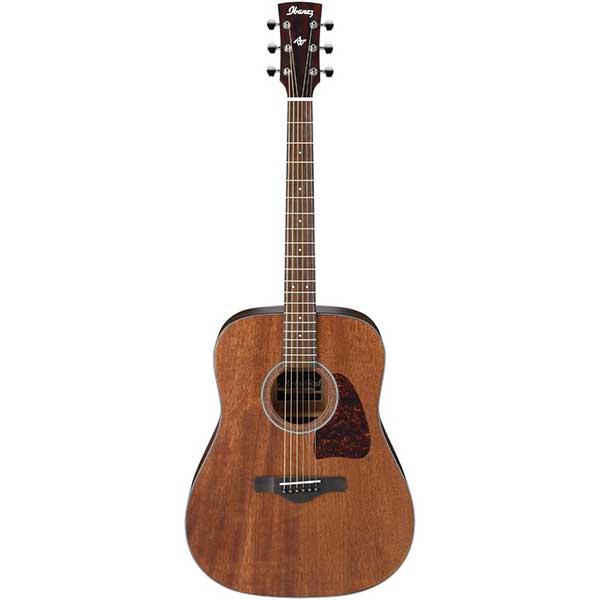
| Estimated Price | $230 |
| Top Material | Solid Okoume |
| Back and Sides | Regular Okoume |
| Finish | Open pore finish |
| Fret Count | 20 frets |
| Manufactured | Japan |
| Preamp | No |
My Review: Overall, the Ibanez AW54 is easily one of the best dreadnought acoustic guitars for beginners, who are looking for an instrument that is capable of delivering high-pitched tones in a direct and precise manner, without any stutters. This model is almost fully equipped with solid Okoume, which allows it to project deep and powerful sound, and that is what dreadnoughts are all about. It features very good responsiveness when strumming, so you won’t have to worry about not being precise enough when playing this guitar. All things considered, Ibanez Artwood AW54 is an amazing acoustic guitar, that will pass most of your expectations, at least for the price you’re paying.
Key Specs and Features: Ibanez AW54 model features a nice, classic look, as well as excellent comfortability, and sound projection. Due to its dreadnought body type, the sound will seem very natural, which is something that cannot be said even for some much more expensive acoustic guitars. Thanks to the Okoume body, the sound it makes will be colorful and deep, alongside the ample sustain. What gives this guitar a special look is a design that makes it look a bit rustic, which is because of the open pore finish. Combined with Ivorex II nut and saddle, you will be able to feel comfortable while playing it, even though it will send the maximum amount of vibrations throughout the body.
Build Materials: AW54 is mostly made of Okoume, which means that this model is capable of delivering very good ample sustain, and powerful fundamentals. It features a dreadnought body shape, with the top side made of solid Okoume, while the back and sides are built from regular Okoume. Along with that comes X bracing, with the bone nut and saddle, making the guitar look very pretty. Apart from that, there is an ovangkol bridge and fingerboard, as well as Nyatoh neck.
Hardware: Ibanez AW54 features 6 D’Addario EXP11 bronze coated 80/20 light (.012-.053) steel strings, along with the 20 frets in total. Radius is 15.7”, while scale length is 25.62”, alongside the 1.69” wide nuts. Apart from that, there are chrome die-cast tuners, allowing you to customize your sound performance to provide you with the best possible tone quality.
Finish: As for the finish, AW54 features an open-pore finish, with the black binding, as well as white dot fingerboard inlay, which, combined with the Okoume construction, makes this model very good-looking.
Who Will Use This the Most: AW54 is most suitable for people who are looking for a cheap acoustic guitar that is capable of delivering top-tier tones of high volume, as well as for those who are looking for an entry-level dreadnought type guitar since it is very easy to set up and use.
Bottom Line: Ibanez AW54 is a very well-made dreadnought type acoustic guitar that can bring joy to a lot of people by offering pretty in-depth high-quality tones, without any sort of trouble, while also being quite comfortable to play, thanks to the excellent design, and top-tier materials from which it was built.
Popular Related Article: Our Favorite Acoustic Guitars Under $500
4. Takamine GC1 NAT (Best Classical)
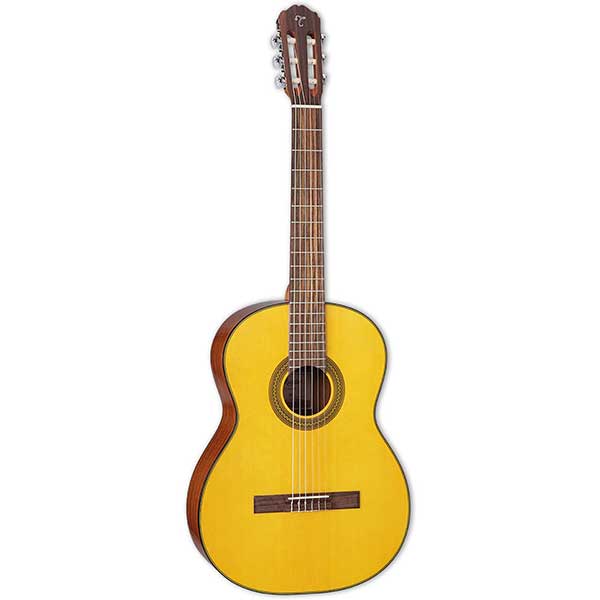
| Estimated Price | $230 |
| Top Material | Top-tier spruce |
| Back and Sides | Mahogany |
| Finish | Gloss finish |
| Fret Count | 19 frets |
| Manufactured | Japan |
| Preamp | No |
My Review: If you are a beginner in the world of acoustic guitars, and you are looking for a perfect starter guitar, then Takamine GC1 NAT is the right instrument for you. Not just that it has a very classic look, but, with it, you will also be able to deliver pretty smooth tones, thanks to the high-quality nylon strings, and body materials. This guitar also seems quite comfortable, which allows you to play for a long time if needed. Even though you might be a bit reserved because of the price, you will be satisfied to hear that GC1 NAT from Takamine performs great, compared even to some of the more expensive acoustic guitars that are currently on the market.
Key Specs and Features: Takamine CG1 features a fan-braced top that is completely made of the select spruce top, alongside the rosewood headcap, with the gloss finish that gives it a classy look and allows it to produce wonderful sound. Thanks to the mahogany parts, combined with the classical chrome tuners, this model can deliver powerful and deep tones without trouble. With a scale length of 25.6”, it is pretty standard in size.
Build Materials: CG1’s top is made of top-tier spruce, with the classical fan body bracing, while the neck, as well as sides and back, are completely made of mahogany, to give it that elite look, and allow it to deliver deeper sounds. The fingerboard is built from laurel, same with the bridge, except the bridge also has a compensated saddle. Apart from that, there is a 2” wide nut, made of synthetic bone, just like the saddle.
Hardware: Takamine CG1 comes with a classical chrome tuner, allowing you to edit the settings, and customize your experience. Along with that come 6 nylon strings from D’Addario, which are EXP45 with normal-tension (.028-.044). Also, the total number of frets is 19.
Finish: This model offers a very classical look, with the gloss finish, classical fan body bracing, and some little details, such as the white pearl buttons on the tuner.
Who Will Use This the Most: CG1 is an excellent choice for everyone who is looking to start their journey towards becoming a great guitarist because it is very simple to use, it is extremely comfortable, and it is capable of showing a great performance.
Bottom Line: Takamine CG1 is a pretty good acoustic guitar, with excellent performance, and great comfortability, which makes it a perfect choice for newbies, as well as for people who prefer the true classical feeling of playing an instrument.
5. Luna Gypsy Grand Concert Acoustic-Electric Guitar
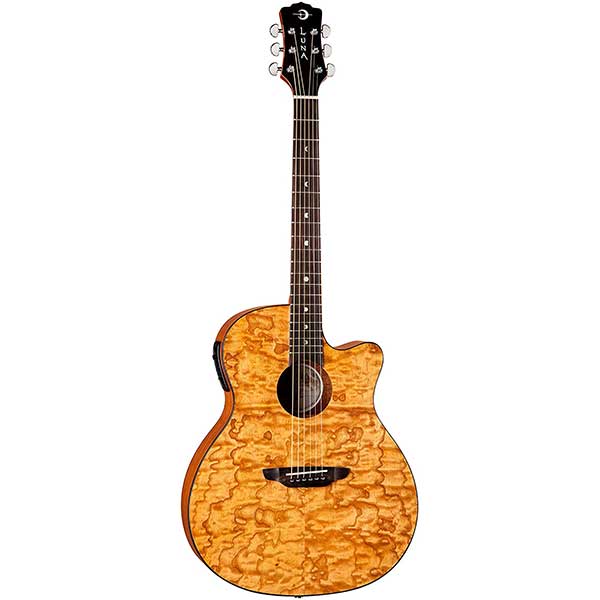
| Estimated Price | $270 |
| Top Material | Zebrawood top |
| Back and Sides | Mahogany grand concert body |
| Finish | Gloss finish |
| Fret Count | 20 frets |
| Manufactured | Florida, USA |
| Preamp | No |
My Review: Luna Gypsy Grand Concert model is an acoustic-electric guitar with quite appealing looks, as well as pretty straightforward playability, combined with the excellent sound performance, while also not being over-expensive. It is a really good choice for starters, allowing them to learn the basics, and even perform with this instrument later. It’s built from very good materials, so you won’t have to worry about it being of poor quality, due to the price. Just like all other guitars from Luna, this one is also made to be accessible to everyone, meaning that you will enjoy every second of playing it, due to it being very comfortable to hold. It will feel like the instrument perfectly fits in your hands, so you will be able to play for hours, without getting tired.
Key Specs and Features: The gypsy model features a grand concert body shape, with the C profile set neck, and Balsamo fingerboard, allowing it to really be very comfortable, even after prolonged playing time. With the 25.5” scale length, as well as 20 frets, with 1.6875” graphite nut, you will be able to comfortably enjoy your own performances. Along with that, there are chrome-sealed die-cast tuners, as well as Luna electronics, which are already pre-built in the instrument. This will help you to further customize your sound performance.
Build Materials: Luna Gypsy is built from top-quality components. Its C-shape neck is built from mahogany, just like the back and sides of the instrument. Top, on the other hand, is engineered from zebrawood, which gives this guitar a pretty unique look. Apart from that, there is also Balsamo bridge and fingerboard, while both nut and saddle are made of plastic.
Hardware: Along with Luna Gypsy, you get 6 steel .012-.053 strings manufactured by D’Addario, one of the best string manufacturers in the world. Apart from that, there are built-in Luna RD-0904TL electronics, as well as the sealed die-cast tuning machines made of chrome, and a total of 20 frets.
Finish: Luna Gypsy comes in a natural color, with a gloss finish, and very nice looks, thanks to the zebrawood. Along with that, there is a black binding, as well as mother-of-pearl moon phases fingerboard inlay, which all combined, makes this guitar very elegant, and pretty.
Who Will Use This the Most: If you are a beginner, who is not sure whether to go for electric or acoustic guitar, Luna Gypsy is a good choice for you because it comes with some electric parts. However, even if you are experienced, you might enjoy this model, since it is quite comfortable and enjoyable to play.
Bottom Line: Luna Gypsy is a very beautiful acoustic-electric guitar, that is not just pretty, but also quite effective. It offers excellent tonal performance, as well as clean and precise sound, with maximum comfort.
Popular Related Article: 17 Best Acoustic Guitars Under $1000 (Review and Buying Guide)
6. Traveler Guitar Ultra-Light Acoustic
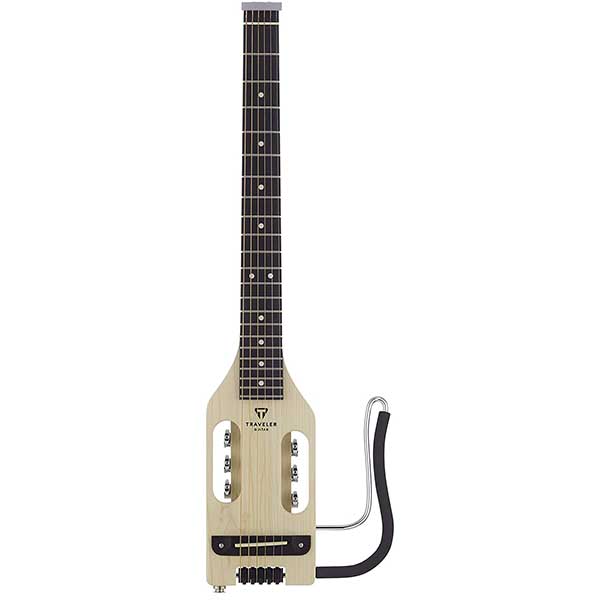
| Estimated Price | $300 |
| Top Material | Tonewood |
| Back and Sides | Tonewood |
| Finish | Satin finish |
| Fret Count | 22 frets |
| Manufactured | California, USA |
| Preamp | No |
My Review: The real question a lot of people are asking is whether a travel guitar can provide decent sound, compared to the classic guitars. Today, I’ll present you Traveler Guitar Ultra-Light Acoustic, which is, just like its name suggests, a guitar you should pick if you need to travel a lot. It features a full-sized neck, but the body is about 31% smaller than regular guitars, while also being 43% lighter. It only weighs around 3 pounds, which is really nothing compared to classic guitars. Along with that comes the built-in tuning system that will let you customize your tones, and figure out the best possible combination, in order to get optimal performance.
Key Specs and Features: This guitar only weighs 3 pounds, and it is 28” long, which makes it perfect for traveling, especially because it can fit almost anywhere. With the scale length of 24.75”, you won’t need to deal with anything, so the feeling would be the same as if you played classical guitar. This guitar is also capable of delivering a pretty good sustain, thanks to the neck, which is made of hard maple. To achieve maximum acoustic tonality, there is a Traveler Piezo Pickup. Also, in order to be able to travel with it, a heavy-duty bag comes with the package itself.
Build Materials: The most noticeable thing about the construction of this guitar is that its entire body, which includes, the top, back, sides, and neck, are made of the same high-quality tonewood, which is Eastern American hard maple. Along with that comes the fingerboard, which is made of black walnut, while it also has a phenolic resin saddle.
Hardware: This model features 6 D’Addario EJ15 steel strings, with a radius of 15.75”, and 22 frets. Its scale length is 24.75”, while the nut is 1.75” wide, along which comes Passive Piezo bridge pickup. There is also closed-gear chrome tuning, with the 14:1 gear ratio.
Finish: Traveler Guitar features an ultra-light acoustic body, with vintage red color and satin finish, as well as dot-shaped fingerboard inlay, making the guitar look very nice.
Who Will Use This the Most: As you can probably notice, this product is the most useful to people who need to constantly travel from place to place, whether it is on some gigs, or simply for enjoyment.
Bottom Line: Traveler Guitar Ultra-Light Acoustic guitar is a pretty good guitar for travelers, which is capable of delivering pretty surprising results, while also managing to be quite compact and easy to fit almost anywhere on your travels. This is an awesome budget acoustic guitar.
7. Fender Alkaline Trio Malibu
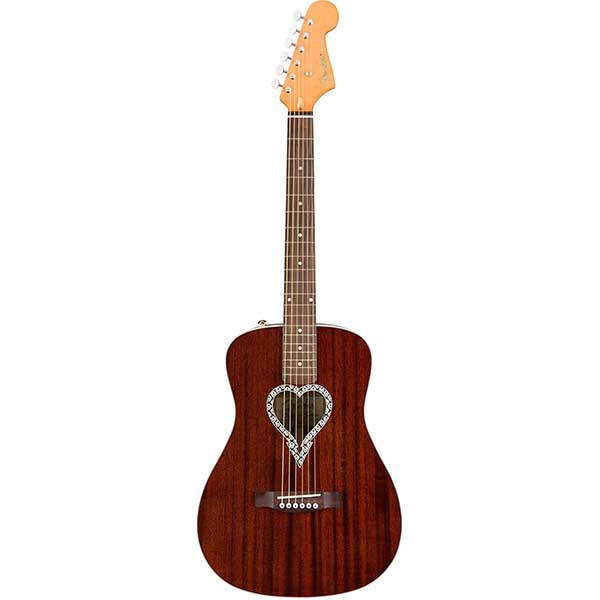
| Estimated Price | $300 |
| Top Material | Laminated Mahogany |
| Back and Sides | Laminated Mahogany |
| Finish | Gloss finish |
| Fret Count | 20 frets |
| Manufactured | Arizona, USA |
| Preamp | No |
My Review: Just like the name suggests, this acoustic guitar from Fender is a tribute to one of the most popular punk bands from Chicago in the ‘60s, Alkaline Trio. This guitar model looks very classy, with a couple of distinctive features to be seen. Apart from that, it sounds really good, so it’s not a guitar, used just for the show. It is also quite comfortable, allowing you to play it during late hours. Whether you like the punk group, you won’t be able to deny that this guitar is a really good product, with balanced tonality, and excellent sound performance.
Key Specs and Features: This model features a smaller acoustic body, while also managing to keep the recognizable Fender look, as well as all the basic features that come from this manufacturer. Because of its design, it’s capable to show great performance, since it is built from laminated mahogany, which is known for its great sound characteristics. One very distinctive feature is the headstock, which is just like the one you can see on electric guitars. Also, the neck is C-shaped, while there is also a heart-shaped soundhole, with some pretty nice details.
Build Materials: Fender Alkaline Trio Malibu is mostly made of the same material, with its top, back and sides being made from laminated mahogany, with the scalloped X-bracing. Neck, on the other hand, is made of maple, while fingerboard and bridge are made of walnut. Apart from that, this model features NuBone nut, as well as Synthetic Bone Compensated saddle.
Hardware: This folk-shaped acoustic guitar features 6 Fender Dura-Tone Coated 80/20 bronze, with .012-.052 steel strings. The total scale length is 25.5 while the number of frets is 20.
Finish: This acoustic guitar from Fender comes in natural color, alongside the gloss finish, and dot fingerboard inlay, which, in combination with the laminated mahogany, looks quite dashing. Another thing that only beautifies this model even further is the heart-shaped soundhole.
Who Will Use This the Most: Even though it is a tributary edition guitar, Fender Alkaline Trio Malibu is not just for the fans of Alkaline Trio, but also for everyone else who enjoys playing and listening to already established Fender quality.
Bottom Line: If you are a big fan of Alkaline Trio, you must get this guitar, especially because it is not too expensive. Also, even if you are not a fan of the group, this Fender guitar is using Fender components and quality, so you can expect great sound performance.
Popular Related Article: Our Favorite Guitars Made in the USA
8. Epiphone DR-212 Dreadnought
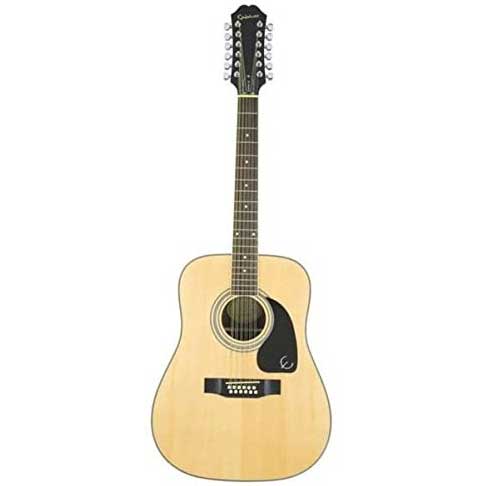
| Estimated Price | $270 |
| Top Material | Select Spruce |
| Back and Sides | Mahogany |
| Finish | Gloss polyurethane finish |
| Fret Count | 20 frets |
| Manufactured | USA |
| Preamp | No |
My Review: With the Epiphone DR-212 dreadnought you will be able to experience the joy of 12-string acoustics, without having to pay a lot of money. Thanks to the select spruce top, combined with the mahogany neck and body, as well as scalloped bracing, this model is capable of producing warm and colorful tones, while also maintaining the power and clarity of the sound. If you need an entry-level 12-string acoustic guitar, then DR-212 is definitely for you, since it is quite affordable, but also features a very well-balanced audio performance.
Key Specs and Features: DR-212 features an excellent natural finish, along with the top made of select spruce, combined with scalloped bracing, which gives nice look to the guitar, as well as very direct sound performance, especially when you consider the powerful effect from mahogany parts. Along with that, you can easily boost up the audio even further, with the chrome tuners, along with the 1.75” wide nut. That, as well as the scale of 25.5”, makes this model look quite classy, combined with the dot fingerboard inlays made of rosewood.
Build Materials: As for the build materials, this guitar is made from the combined use of materials, such as spruce, mahogany, and rosewood. Its top side is made of spruce, while its D-shaped neck, back, and sides are made of top-quality mahogany. Fingerboard and bridge are both built from rosewood, while nut and saddle are made of plastic, which is the only downside of this build. Apart from that, there is also a scalloped bracing.
Hardware: Epiphone DR-212 uses 12 steel .011-.052 strings, allowing it to produce much stronger sound, compared to the 6-string acoustics. To boost the tone effect even further, there are standard chrome tuners, as well as 20 frets.
Finish: DR-212 has a pretty classic look, thanks to the natural color, and gloss polyurethane finish, combined with the binding on both neck and body.
Who Will Use This the Most: This model is great for people who are looking to get into the world of 12-string acoustic guitars because, compared to most other guitars with 12 strings, this one is quite affordable, while also being able to offer excellent tones.
Bottom Line: Epiphone DR-212 is a well-made 12-string acoustic guitar, capable of delivering high-pitched tones with immense clarity, while also being able to maintain enough comfort to keep you going for hours.
9. D’Angelico Premier Fulton LS
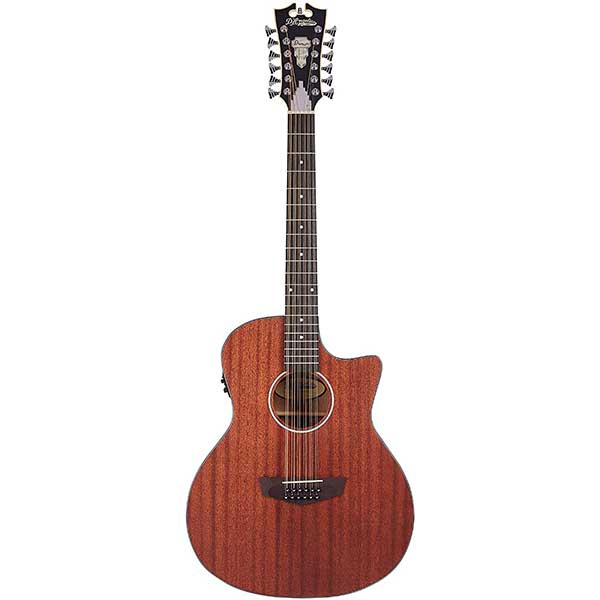
| Estimated Price | $300 |
| Top Material | Mahogany |
| Back and Sides | Mahogany |
| Finish | Satin finish |
| Fret Count | 20 frets |
| Manufactured | California, USA |
| Preamp | Yes |
My Review: One of the first, if not the first 12-string acoustic-electric guitar from D’Angelico, the Premier Fulton LS model can deliver amazing sound, with the minimum effort. Thanks to the grand auditorium body type, combined with the smaller build of 16 inches wide-body, you will be able to experience a pretty good bass effect and wonderful high-pitched end with complete clarity. Not just that, but this model is also simply beautiful, thanks to the all-mahogany body, combined with the torrefied Merbau fingerboard. Along with that come D’Angelico’s own MG-30 Preamp and Tuner, allowing you to boost the signal, and achieve an even greater acoustic effect.
Key Specs and Features: Premier Fulton LS features a smaller body, with the grand auditorium shape, which, combined with the fact that it has 12 strings, can boost the way you play. Mahogany parts just make it sound even better and allow it to offer clean, and precise tones, with the optimal response. To further amplify the effect, there is a built-in tuner, which comes alongside the D’Angelico preamp. To make your user experience even more enjoyable, this model comes with a C-shaped design, allowing you to comfortably hold the instrument in your hands for hours, especially when combined with the 20 medium-sized jumbo frets. For maximum durability, there is an X-scalloped bracing, as well as a torrefied Merbau bridge for improved resonance.
Build Materials: The neck, top, back, and sides of this guitar are completely made of top-tier mahogany wood, while there is also a scalloped X-bracing, to ensure that the instrument has more durability. Apart from that, the bridge and fingerboard are both built from torrefied Merbau, while nut and saddle are made of a bit cheaper material, plastic.
Hardware: D’Angelico Premier Fulton LS has 12 D’Addario steel strings, with a maximum radius of 14”, and a total of 20 medium jumbo frets. Also, there is a Stairstep Wave Mini tuner, alongside the D’Angelico MG-30 preamp with the built-in tuner.
Finish: As for the looks, this model features natural color with a satin finish and 3-ply black and white binding. Apart from that, there is Acrylic Pearl dots fingerboard inlay, to make everything look even smoother.
Who Will Use This the Most: This guitar is a good choice for people who are interested in trying out the grand auditorium body shape, but of a smaller size, without having to lose the sound performance. It is perfect for solo performers, as well as professional crews.
Bottom Line: D’Angelico Premier Fulton LS is a masterfully-made 12-string acoustic guitar capable of producing top-notch tones, even though it is not a full-sized grand auditorium instrument.
Related Article: Our Favorite Acoustic Guitars for Beginners
10. Washburn Classical C40 Nylon String Acoustic Guitar
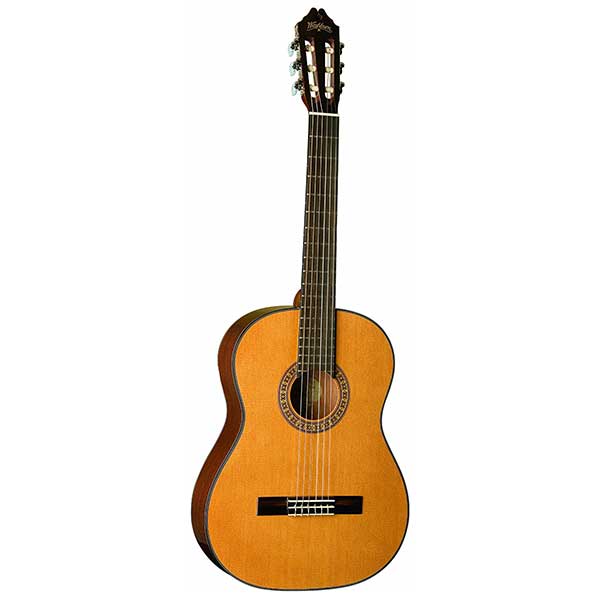
| Estimated Price | $190 |
| Top Material | Spruce |
| Back and Sides | Mahogany |
| Finish | Gloss finish |
| Fret Count | 19 frets |
| Manufactured | Illinois, USA |
| Preamp | No |
My Review: If you want to get a nylon-string guitar that offers soft tones, then the Washburn C40 series is a product for you. Thanks to the combination of spruce, Sitka spruce, and mahogany, this instrument is capable of delivering precise and warm sound, with an excellent sense of tonal projection. To enhance the experience, even more, thanks to the mahogany neck, as well as the rosewood fretboard, this guitar is an absolute joy to play, due to its comfortability. Because of all that, this model, in particular, is an excellent choice for beginners, especially since nylon strings are much more relaxed, so their tension is lower, meaning that the chances of breaking them up are lower. With this guitar, you will be able to play various music genres, such as classical music, jazz, or even flamenco.
Key Specs and Features: C40 series comes with a truly rich sound, because of its high-quality nylon strings, combined with the tonal range offered by high-quality tonewoods this guitar is made of. Along with that, there is a quartersawn X-scalloped bracing made of Sitka spruce, which is really helpful, when it comes to increasing the durability, as well as the balance and projection of the sound. Wide nut, as well as mahogany neck, combined with the fretboard made of rosewood, increases the amount of comfort you get when playing this guitar.
Build Materials: Washburn Classical C40 is built of the highest-quality materials, to enhance the sound quality, durability, and comfort. Its back and sides are built from mahogany, as well as the neck itself. The top is made of spruce, while there is also quartersawn Sitka spruce body bracing, for maximum durability. The fingerboard is built from top-notch rosewood, while the bridge is created from the engineered wood. Saddle and nut are both NuBone.
Hardware: C40 from Washburn features 6 D’Addario nylon EXP-16 light set Phosphor Bronze strings, which, alongside the chrome Die-cast tuner, and 19 frets allow you to make beautiful sounds, with great comfortability.
Finish: C40 comes in a natural color with a standard gloss finish, and a pretty classic look, which is neither fancy, nor boring, but simply beautiful.
Who Will Use This the Most: Because of the nylon strings and comfortable experience, this acoustic guitar is perfect for new players, who need to get used to the controls, finger-movement, and to get the sense of how the guitar works at all in general.
Bottom Line: Washburn C40 is an excellent nylon string acoustic guitar, which can deliver pretty neat tones, with the minimum effort, allowing you to focus on important things while learning to play the guitar, while also not being too simple for professionals, who want to take the maximum out of it.
11. Mitchell Element Series ME1 Dreadnought
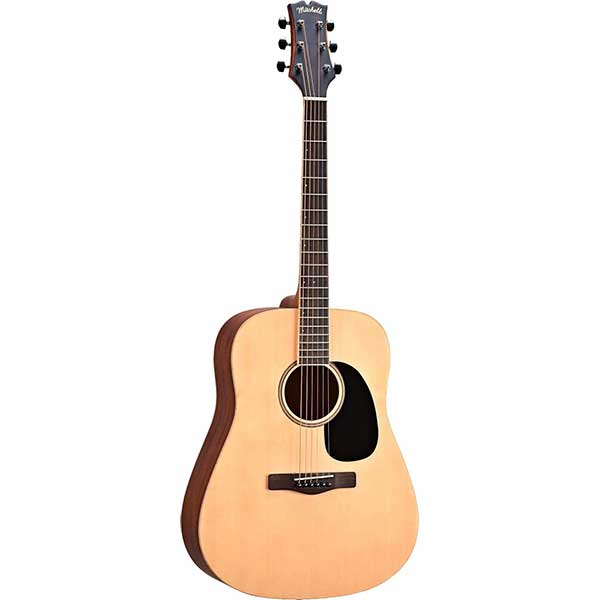
| Estimated Price | $250 |
| Top Material | Select Spruce |
| Back and Sides | Striped Sapele |
| Finish | Satin finish |
| Fret Count | 20 frets |
| Manufactured | Virginia, USA |
| Preamp | No |
My Review: Guitars from the Element Series are amongst the best products Mitchell has to offer, which also includes this ME1 dreadnought-shaped body acoustic guitar. With the combination of the top-quality tonewoods and the manufacturer’s expertise, this instrument is capable of producing superior sound quality and performance. It also has a great tonal projection, thanks to the solid spruce top, as well as the sides and back, which are made of Sapele. Along with that comes very special scalloped X-bracing, made to improve the total amount of resonance this guitar has to offer. To make it look even better, there is an extremely pretty flame maple binding, combined with the satin finish.
Key Specs and Features: ME1 from the Mitchell’s Element Series is a masterfully-crafted product made of premium materials, which, all combined, allow it to deliver the best-level sound quality. It can further be improved by using Die-cast tuners, which have keys made of ebony. Thanks to that, and the carefully-crafted neck, this guitar is an absolute joy to play since it is very comfortable.
Build Materials: This dreadnought acoustic guitar is made of a combination of different tonewoods. The body consists of the top built from solid select spruce, back and sides carved from the striped Sapele, rosette made of both Sapele and maple, and flame maple binding. On the other hand, ME1 features a C-shaped neck, with a nut width of 1-11/16, as well as a fingerboard made of rosewood. The neck itself is carved from mahogany, while the bridge is built from the select hardwood. The nut is Nubone TUSQ, along with the compensated saddle.
Hardware: Mitchell’s ME1 from the Element Series features 20 frets, and the total scale length is 25.5”. To boost the power and tonality, there is a Die-cast chrome tuning machine, and included electronics on the neck, without the preamp.
Finish: When it comes to the looks, this dreadnought non-cutaway acoustic guitar features a shifted scalloped X bracing pattern, with the lightly rubbed satin finish, as well as abalone dots on neck inlay, which makes it look pretty classy.
Who Will Use This the Most: Just like most other guitars from this list, this one is also newbie-friendly, but it can be used by anyone, both beginners and professionals alike, due to its excellent performance in most situations.
Bottom Line: Mitchell Element Series ME1 dreadnought is a pretty good acoustic guitar, that will let you play wonderful tunes, while also being quite comfortable, and beginner-friendly.
Related Article: The Different Types of Acoustic Guitars Explained
12. Recording King Dirty 30’s Series 7 RDS-7 Dreadnought
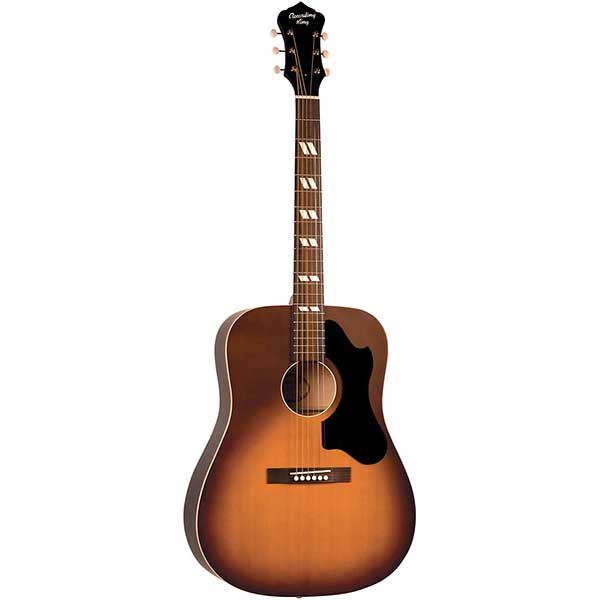
| Estimated Price | $170 |
| Top Material | Premium Spruce |
| Back and Sides | Whitewood |
| Finish | Satin finish |
| Fret Count | 20 frets |
| Manufactured | California, USA |
| Preamp | No |
My Review: Dirty 30’s series 7 of dreadnought guitars from Recording King is immensely popular, because of which it is not a surprise to see another addition to the series. RDS-7 is a beautiful piece of art, available in two different finishes, depending on your taste, which is Tobacco Sunburst and Matte Black. It produces one of the best-quality tones, compared to competitors on the market, thanks to the spruce top, and bound soundhole. It is also very comfortable to play since it features stencil fretboard markers in the shape of a parallelogram, which cannot be seen on many guitars, making it pretty innovative, but also very comfortable to use.
Key Specs and Features: RDS-7 features a pretty good dovetail neck joint, with the top body binding made of ivory, which makes the instrument look elegant, as well as letting it to provide amazing sound. Next to that, we have a bound soundhole, with a straight bridge, and parallelogram stencil fingerboard inlays, for innovative looks and maximum comfort. To match the top binding, bridge and end pins have the same color as ivory, and there is also an RK Whitley pickguard that is completely black.
Build Materials: This elegant acoustic guitar is made of a combination of different tonewood. The topside of the body is built from premium spruce, while the back and sides of the body are carved from whitewood. Apart from that, RDS-7 comes with a thin C-shaped neck, made of Nato wood, and Revenond fingerboard, for maximum comfort, while saddle and nut are made of compensated bone.
Hardware: This model comes with 6 strings, as well as a total of 20 frets, while the nut is 1.69”, or 43mm wide. There is a manual ivory tuner, to let you customize the sound quality a bit. However, this acoustic guitar doesn’t feature any electronics, such as a preamp, electronic tuner, feedback filter, configuration, etc.
Finish: RDS-7 comes with a satin body and neck finish, with the black headstock overlay, making the entire instrument look quite elegant and pretty.
Who Will Use This the Most: This model is usable by everyone, but especially for those who appreciate an elegant and good-looking design, combined with excellent sound quality.
Bottom Line: Recording King RDS-7 Dreadnought from the Dirty 30’s series is an acoustic guitar that is beautifully-crafted and is capable of producing amazing natural sound, without having to hook up to any amplifiers.
13. Rogue RA-090 Dreadnought 12-String
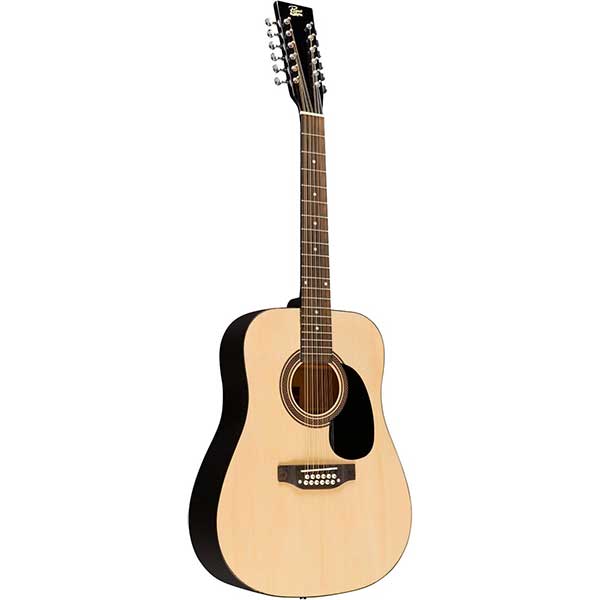
| Estimated Price | $170 |
| Top Material | Whitewood |
| Back and Sides | Whitewood |
| Finish | Gloss finish |
| Fret Count | 20 frets |
| Manufactured | Oregon, USA |
| Preamp | No |
My Review: One of the most popular 6-string acoustic guitars from Rogue finally got its 12-string version, in the form of RA-090 dreadnought guitar. It is considered to be one of the best guitars with 12 strings for people who need to be introduced to such guitars. It is very easy and comfortable to use, which is also one of the reasons why it is so popular. It features a balance between every part of the body and neck, which gives a completely clean projection, and in-depth sound, with perfectly spread vibrations across the instrument.
Key Specs and Features: Because it is built from top-tier materials, this acoustic guitar is capable of giving you a wide variety of tones, as well as perfectly balanced sound projection, across the entire area. With the manual open gear nickel tuning, you can further customize how your instrument will sound, which allows you to play different genres, without too much trouble. Along with that comes the X-bracing pattern, which increases responsiveness, and durability.
Build Materials: This dreadnought body type non-cutaway acoustic guitar has a top, back, and sides, that are carved from premium-quality laminated whitewood. The fingerboard and bridge are both built from simulated rosewood, while the neck is made of Nato wood. Nut and saddle are both built from plastic materials, that are painted in ivory color, to look more appealing.
Hardware: RA-090 features 12 high-quality strings, with a scale length of 25.4”, and 20 frets, alongside the Open Gear nickel tuning, to help you customize your tunes. It doesn’t include any electronics, and the case is not included in the package but sold separately.
Finish: This model comes with a gloss finishes on both body and neck, with the headstock overlay being black. Combined with the classic look, and natural wood color, this guitar looks amazing and quite elegant.
Who Will Use This the Most: Rogue RA-090 is the most suitable for players who want to start playing on 12-string acoustics since it is relatively easy to use, while also featuring pretty good sound quality, and all of that at an affordable price.
Bottom Line: RA-090 model is a great 12-string acoustic guitar, with excellent sound projection and responsiveness, which is especially good for entry-level players, at least when it comes to the guitars with 12 strings.
14. Daisy Rock Pixie
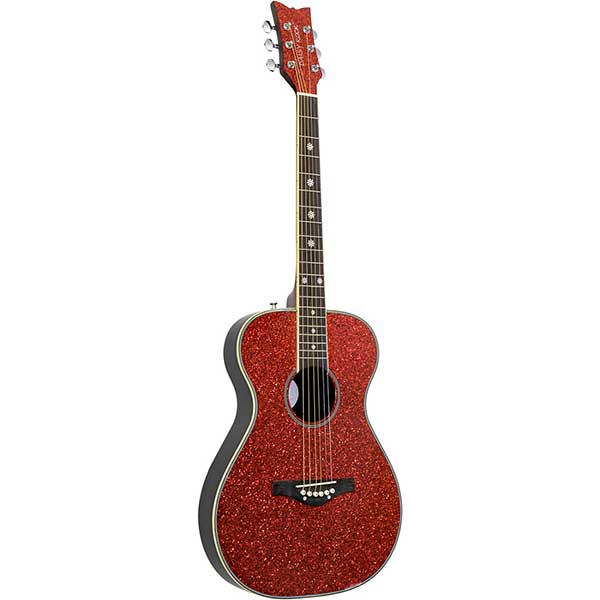
| Estimated Price | $200 |
| Top Material | Spruce |
| Back and Sides | Composite oval back |
| Finish | Silver or Pink Sparkle finish |
| Fret Count | 20 frets |
| Manufactured | California, USA |
| Preamp | No |
My Review: Daisy Rock Pixie is an acoustic guitar with a unique design, which is made like that to appease the female population. In other words, this guitar is designed for girls, which is obvious from the first time you set your eyes upon it. It basically glows because of a sparkle finish, which makes it look quite fancy, to be honest. Apart from that, it is a relatively normal guitar, capable of producing excellent sound. However, what sets it apart from other guitars is that it has an official trademark of Daisy Rock, which includes the ‘slim & narrow’ neck, which helps to increase the comfort for players. That is perfect for girls with smaller hands. Also, the body of this guitar is relatively smaller, which is also excellent for females.
Key Specs and Features: Daisy Rock Pixie features quite a popular ‘slim & narrow’ neck, which increases comfort during playing. Along with that comes the weight of 4lb, which is great for girls who need to carry it a lot, for instance in traffic, or travels. To increase durability, this guitar has a composite oval back. To further assist the players, Daisy Rock Pixie comes with an already done setup, so you can play as soon as you get the package. Apart from that, there is a lifetime warranty on the product, in case something happens.
Build Materials: This guitar has a set-neck construction with a composite oval back. The top is carved from the premium-quality spruce, while the neck is built from mahogany tonewood, combined with the rosewood fingerboard.
Hardware: Daisy Rock Pixie features 20 medium frets, alongside D’Addario EXP 11 strings, and a custom chrome tuner with the Daisy logo.
Finish: As for the finish, you can choose between the silver or pink sparkle finish, depending on your preference. In any case, the product will look very pretty, especially with the daisies on the inlay.
Who Will Use This the Most: As stated above, this acoustic guitar is the most suited for girls, due to it being all sparkly, lightweight, and smaller in size.
Bottom Line: All in all, Daisy Rock Pixie is a relatively good acoustic guitar, that looks quite fancy, and, even though it is cheap, it is capable of delivering pretty amazing tones, while also being extremely comfortable to play, due to its smaller size.
15. Rogue Starter Acoustic Guitar
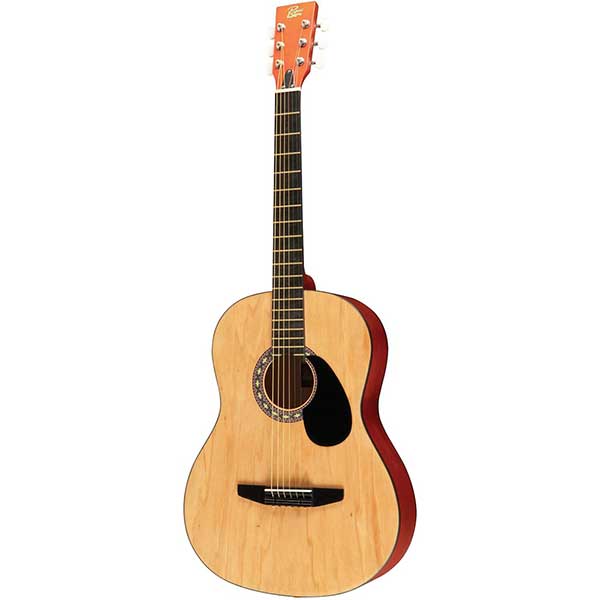
| Estimated Price | $100 |
| Top Material | Mahogany |
| Back and Sides | Mahogany |
| Finish | 6 different finishes available |
| Fret Count | 19 frets |
| Manufactured | Oregon, USA |
| Preamp | No |
My Review: Another great acoustic guitar from Rogue, as you might have expected. Rogue Starter Acoustic Guitar is a bit smaller than regular guitars (7/8” scale), which makes it a bit more comfortable to use. Also, with it, you will be able to make decent tones, thanks to the maple neck, as well as the rosewood fretboard. Apart from that, it features Martin strings, which is one of the most popular string manufacturers in the world. All this makes this guitar perfect for beginners, especially for children.
Key Specs and Features: This model from Rogue features a smaller body, which makes it perfect for kids who want to learn how to play the guitar. The smaller body and high-quality materials make it very comfortable to play, as well as allow it to produce pretty good tones, thanks to the maple and rosewood parts, as well as Martin strings. It doesn’t come with a case, it is sold separately.
Build Materials: Rogue Starter Acoustic Guitar is made of nice materials. It features a maple neck, as well as a rosewood fretboard, which allows it to have a very balanced sound projection.
Hardware: As for the hardware you can expect, this guitar comes with 6 high-quality Martin strings, which means that you can expect pretty good sound-quality from it.
Finish: As for the coloring, there are 6 different styles to choose from: blue burst, matte natural, pink, red burst, walnut, and black. Some look pretty classic, but some, such as blue burst, are very beautiful, especially if you like different styles combined.
Who Will Use This the Most: Due to its smaller size and simplicity, this acoustic guitar is the most suited for beginners and children.
Bottom Line: Rogue Starter Acoustic guitar is a pretty balanced piece of work, capable of producing decent tones, at an extremely affordable price, while also being amazingly easy to use.
16. Jasmine S-34 Cutaway
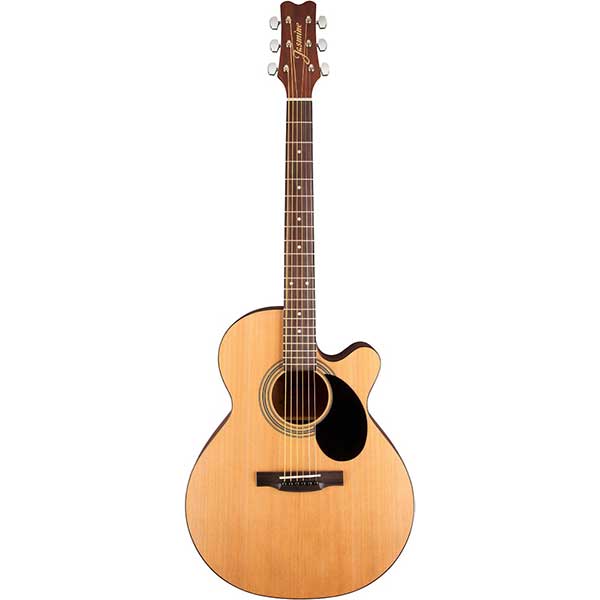
| Estimated Price | $120 |
| Top Material | Spruce wood |
| Back and Sides | Spruce wood |
| Finish | Satin and gloss finishing |
| Fret Count | 20 frets |
| Manufactured | Connecticut |
| Preamp | No |
My Review: S-34 Cutaway model from Jasmine features grand orchestra body type, as well as extremely good tone projection. It is perfect for people who are looking for an acoustic guitar that is well-made and simple to use. S-34C comes with a spruce top, as well as with the advanced X-bracing directly from Jasmine, alongside the Sapele back and sides, which allows it to have warm but decisive tones. Apart from that, it is also quite comfortable to use, since it features a pretty slim neck and 25.5” scale length, which, combined with the satin finish, adds to both comfort and tone quality.
Key Specs and Features: This model comes with an advanced X-bracing top from Jasmine itself, with a scale length of 25.5”, or 648mm. The fingerboard radius is 12” or 305mm. Apart from that, other parts are made of premium materials, allowing this guitar to produce wonderful tones, without any trouble. And with the chrome tuner, you can boost that effect even further.
Build Materials: It features a Jasmine top made of spruce, while the back and sides are carved from Sapele. Fingerboard and bridge are both made of rosewood. Also, the instrument features a slim Nato neck, while the saddle and nut are carved from synthetic bone. Bridge pins are built from black plastic, while the machine heads are covered with chrome.
Hardware: Jasmine S-34C features a total of 20 frets, alongside the Phosphor Bronze Light Gauge .012-.053 strings, as well as chrome tuner, but without any special electronics.
Finish: This guitar has a pretty decent natural color with satin finish on the neck, and gloss finishes on the body, making it look very elegant.
Who Will Use This the Most: This model is perfect for people who are looking for a very affordable, and yet pretty decent acoustic guitar, which is both comfortable to play, as well as good enough for some casual performance.
Bottom Line: Jasmine S-34 Cutaway is a pretty good acoustic guitar that is easy to set up, comfortable to play, as well as affordable enough for both experienced and new players.
17. Washburn Apprentice G-Mini 5
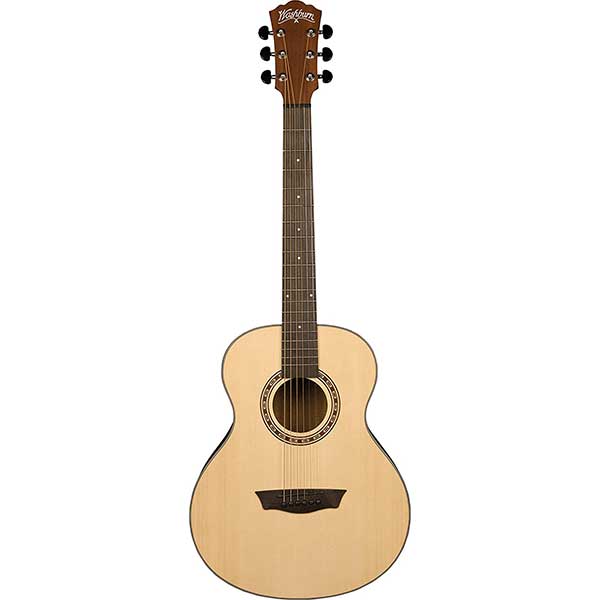
| Estimated Price | $200 |
| Top Material | Spruce |
| Back and Sides | Mahogany |
| Finish | Gloss |
| Fret Count | 20 frets |
| Manufactured | Illinois, USA |
| Preamp | No |
My Review: Washburn Apprentice G-Mini 5 is one of the best traveling companions you can have with you on your journeys. It is suited for both beginners and experts alike, with high comfort, good durability, as well as amazing sound quality. It is perfect if you want to hang out with your friends on camping trips, beaches, or even just being on the road.
Key Specs and Features: This acoustic guitar features a smaller body size, with the 7/8th of the regular guitar size, allowing you to carry it with you wherever you want. Even though it is smaller, it can still hit a decent punch, and produce wonderful tunes, just like some larger acoustic guitars, due to its grand auditorium shape, which allows it to have increased resonance and sound projection. The spruce top also helps with that, by increasing the richness of the sound, while mahogany back and sides tend to spread the tone more equally, creating a perfect balance.
Build Materials: G-Mini 5 comes with a mahogany back and sides, while the top is made of high-quality spruce tonewood. The neck is also made of mahogany, which makes this guitar’s build perfectly balance, and allows it to create great tunes.
Hardware: This model features 6 light gauge bronze strings, which alongside the well-balanced build, offer excellent sound quality.
Finish: G-Mini 5 has a natural color, with a gloss finish. Due to the natural wood color, it looks very elegant, and classic, which is appealing to some people.
Who Will Use This the Most: This acoustic guitar is suitable for anyone, whether they are beginners, casual players, or professionals.
Bottom Line: With all that was said about G-Mini 5 acoustic guitar, it can be concluded that it is definitely a very good acoustic guitar, due to the quality of the sound, as well as the cheap price, compared to other guitars in the same niche.
Choosing a Quality Cheap Acoustic Guitar (Buying Guide)
Cheap acoustic guitars are like, well, you know how the old saying goes. Everyone seems to have one. Or, more accurately, every guitar manufacturer out there seems to have a model, or a ton of models that fit squarely into the “under $300” market. Yeah, there are a ton out there, which can be kind of overwhelming.
I mean, really, they’re all just pieces of wood glued together with a bunch of wires (strings, that is) on them, right?
Well…yes…and no. While it’s true that the overall construction is the same, there are a ton of different factors that you should be considering. But with all of the options available, how could you possibly ever know that you’ve found the best cheap acoustic guitar that’s available on the market?
Regardless of the reason why you are looking for a cheap acoustic (such as budget limitations, not looking for the best model, wanting to find a good beginner’s model, just to name a few), you’re bound to wonder why one may be better than another. That’s exactly what I’m here to do – help you to navigate through these shark-infested waters.
Saddle up, partner, you’re about to know everything you ever wanted to about acoustic guitars.
Cheap Doesn’t Mean Junk Necessarily
Let’s get a popular misconception out of the way before we go any farther – ‘cheap’ does not necessarily mean ‘low quality’ or ‘junk’. I won’t deny the fact that many hold this opinion for good reason. A few decades ago, it was almost a sure bet that a cheap guitar was, in fact, most likely to not be very good.
In fact, they were typically pretty bad. Cheap materials + poor manufacturing techniques were a pretty solid equation to get an acoustic guitar that was, many times, simply an awful experience to own. String action (the height of the strings above the fretboard) could be so high that you’d have to use a C-clamp to fret any notes.
And the sound? Forget it. You could take a cereal box, cut a hole in the front, tape a cardboard tube to it, and use rubber bands for strings and still get a better sonic experience.
On the flip side, nowadays you’ll find a whole new ball game at this end of the market. Construction and manufacturing techniques have evolved to a level that was unheard of 30 years ago. Many of the non-US based locations known for building guitars (South Korea, Indonesia, to name a few) are rapidly gaining respect and a reputation for consistent, higher quality builds.
It’s not uncommon anymore to come across lower-cost models that are almost as good as any domestic guitars that you may think are out of your range.
The moral of the story? Don’t look at a cheap acoustic guitar as necessarily being ‘less than’ or ‘not worthy’. You just may run across a model that’s better that fits you and your playing preferences better than another one that can cost several times more…
What I’m Calling “Cheap”
While I’m throwing around the word ‘cheap’ fairly generously here, it should help to define what I’m actually referring to as we go down this particular yellow brick road. For the models that we are going to look at, I’m targeting models that are up to $300. That will bring some lower-to-mid level models into the fold, and expand the overall level of what can be found at this end of the scale.
The Anatomy of An Acoustic Guitar
All of this talk about price, quality, and value really doesn’t mean a whole lot if you’re a beginner that may not know what to look for in a good acoustic guitar. It’s time for a look at all of the components; having a basic knowledge of what goes into making a good guitar will leave you better informed while shopping around.
Body:
The body is the largest part of an acoustic guitar, and it’s pretty much the first thing that you notice when you take the first glance. This is where most of the magic happens, as the body is the component that primarily determines the overall tone. It is made up of three distinct components:
Top:
The top of an acoustic guitar is the part that faces away from you when you hold it. It incorporates the traditional sound hole that is located in the general area of where your picking/strumming hand would go.
In the simplest terms, how an acoustic guitar works are that the vibrations from the strings (as they are played) are transferred to the top. They then resonate through the rest of the body, exiting out through the soundhole itself.
It’s a thin piece of wood, for sure, but strength is added by a pattern of wood bracing that is glued to the underside (inside the body itself). Not only do these bracings add rigidity, but they also can be designed to maximize the vibration transfer, which in turn can help to balance out the overall sound.
Traditionally, higher-end guitars used solid pieces of wood for the top (Sitka spruce is a very popular choice). With this level of quality came at a higher price, though, so many of the less expensive models used some sort of laminated material. That being said, many mainstream manufacturers are starting to offer solid tops on their cheaper models, making them even more attractive to the buyer.
Sides:
In a nutshell, a guitar body is basically a big boxy enclosure. But think about that for a second – would you want to play the guitar that was shaped like a rectangle? Didn’t think so. Not only would that be extremely uncomfortable, but the tone may suffer as well.
Here is where the sides of a guitar come in. Guitar bodies are configured with large round contours, the sides are formed pieces of wood that allow the body to maintain the overall shape of the top.
Most acoustic guitars use a laminate material for the sides, even the top-end models. It’s certainly not a point of concern if the guitar you’re considering has them – it’s to be expected. The laminate construction also helps to add strength to the body overall, as the sides create the depth that a guitar body needs to project sound as it was intended to do.
Back:
Lastly, we have the back of the guitar. More often than not, the back is also made from a laminate material, and it follows the same shape as the top. Without the back, the guitar body would not be an ‘enclosure’. The physics of how an acoustic guitar works are dependent on having a closed space and the back provides that structure.
Some guitar makers have branched out a bit, using innovative materials to hopefully improve the classic acoustic guitar design. A prime example is an Ovation. With an Ovation acoustic guitar, you won’t find the typical wooden back. Instead, they use a material called Lyrachord to create a rounded shell that not only takes the place of the back but the sides as well.
These kinds of guitars are unique in the sense that not all players may like them. They do have a different feel (since they aren’t so ‘boxy’), and they also have a tonal profile that is different from traditional acoustics that are constructed completely out of wood.
Neck:
Do you know that long stick-looking thingy that sticks out from the guitar body? That’s called the neck. Its purposes in life are to create an extension of the body of the guitar where the strings can be attached, along with having an area where you place your fretting hand to create notes and chords.
(Side note – that’s how a guitar works: by placing your fingers on the strings, you effectively shorten their length, therefore changing the pitch of the note. The shorter the length of the string – that is, fretting notes closer to the body – will give you a higher pitch as compared to playing farther away, or even playing the string open)
Just as with the body, the neck has several distinct components of its own.
The ‘neck’ itself:
This is the main piece of wood that is glued to the body and sticks out for another few feet. The neck is designed to be very strong, as it has to work to stay straight against the tension that all of those steel strings have when they are tuned up to proper pitch.
The vast majority of acoustic guitars – regardless of the price point – are constructed out of maple. Maple is an excellent wood for this purpose. Not only is it strong, but it also has tonal qualities that are desirable for good sound and vibration transfer to the body. While it is strong, for sure, most guitars also have a steel rod (called a truss rod) running down the length of the neck to help things out…you’d be surprised at how much stress and tension those thin steel strings can produce!
Fretboard:
The fretboard is located directly under the strings. It is the playing surface where you will put your fingers while playing a note. Here you’ll find a good number (usually around 20 or so) pieces of thick steel wire that run perpendicular to the length of the neck itself. These are called frets, and they are the points where the string contacts to change its effective length.
Fretboards are made from many different types of wood, with the most common being rosewood. Rosewood is a protected species, though, so many manufacturers use more sustainable materials in its place. That’s not typically a bad thing; while there can be some tonal differences, it’s typically not enough for most players to really notice all that much – especially if you’re a beginner. The bottom line is that having a material other than rosewood should not be any sort of deal-breaker for you.
Headstock, bridge, and hardware:
The headstock is located at the far end of the neck. Here is where the strings are attached to the neck, by use of what are called ‘tuning machines’. These are little gearbox units that are designed so when you turn the tuner button, a round post then turns and tightens (or loosens) the strings so they can be tuned to the proper pitch.
The bridge is typically an assembly that is glued to the top of the body, and it provides the main contact point where the strings are attached (with the other end going to the far end of the neck). Bridges have pieces called saddles that are the exact point of contact, and they can be made out of many different types of materials (plastic being the most common).
Metal hardware on an acoustic, for the most part, is pretty simple. Apart from the tuning machines mentioned above, there isn’t typically much more, save for the strap buttons that are typically located on the end and by the neck joint.
Types of Acoustic Guitars
While shopping for the best cheap acoustic guitar for your needs, you’ll run across a wide variety of shapes and sizes. This is by design – each type has its own characteristics that set it apart from the others. Going into each and every type would take up a bit of time, so we’re going to do a short focus on the three main styles that you are most likely to encounter.
Dreadnought:
Dreadnought guitars are the most popular acoustic guitars that you’ll come across. This classic design is very versatile, having been used by just about every major league player you can put in your mind’s eye. They are the standard for playing comfort, playability, and volume projection.
Parlor:
With a parlor guitar, you’ll find a much smaller shape than that of a dreadnought. Its size makes it a bit more manageable, but it can come with some concessions – the tone may not be as deep and rich, and the amount of volume it produces will be lower than that of a guitar with a larger body.
For reference, the bigger the body, the louder the guitar will be. That’s simply because there is more room for the vibrations to bounce around before exiting through the soundhole.
However, you shouldn’t take the size as the definitive factor, since some smaller guitars can also provide quite high-pitched tones.
Auditorium:
Landing smack dab in the middle between the dreadnought and the parlor, the auditorium is the perfect halfway point between the two. It’s small enough to be comfortable without being too small, and big enough to provide a sound that, while not as full as a dreadnought, has a range that may be more pleasing than some parlor sized models.
Travel:
Most travel guitars are simply miniaturized versions of their big brothers. Both the body and the neck are proportionally smaller, many times up to ¾” the size. They are the perfect solution for guitarists that may struggle with lugging around a full-size instrument.
They are also often used as kids’ guitars. The reduced size of the neck and body tend to fit a child’s size better. Another benefit is that the frets are closer together, which makes forming chords a lot easier for those smaller hands.
Electronics:
Old school electric guitars have no way to get them louder. If you’re playing live or are in a recording environment, your only choice is to use microphones. That may be the right choice for particular applications (truthfully, the studio is the prime place to use mics), but putting a little technology in an acoustic can greatly enhance its flexibility.
Acoustic guitars across the entire price spectrum now feature onboard electronics setups. That typically means some sort of pickup with a preamp unit that adds extra features.
The pickup type used most often is called a ‘piezo’. Piezo systems are made up of crystals that take vibrations and translate them into voltage. These types of pickups are typically set in under the bridge saddle, giving it one of the best places for vibration transfer. While they are easy to use, they can have a nasal, almost ‘quack’ style tone, especially if you hit the strings pretty hard.
While a piezo tone can be completely acceptable, some systems also use small microphones that are mounted on the inside of the body in combination with the piezo itself. The purpose of this is to help round out the piezo sound, making it more full and giving it the low mid and bottom end that some piezo setups don’t naturally provide.
A preamp is a small unit that is usually mounted to the upper bout of the body, facing up. Depending on the model, you’ll find a wide range of options. Some are relatively simple with just a volume and tone knob, while others have multi-band EQ systems, notch and phase controls (which help to control feedback), and accurate chromatic tuners.
So what is the best cheap acoustic guitar on the market?
Simply put, it all boils down to this one thing and it’s something that any beginner should keep in mind for as long as they play the guitar – the best guitar is the one that checks all of your particular boxes.
The right guitar for you is that perfect mix of price, comfort, playability, and tone. Sounds a little vague, right? Yeah…we get it. But the fact is that what works best for one person may not be the best choice for another.

My name is Chris and I’ve had a passion for music and guitars for as long as I can remember. I started this website with some of my friends who are musicians, music teachers, gear heads, and music enthusiasts so we could provide high-quality guitar and music-related content.
I’ve been playing guitar since I was 13 years old and am an avid collector. Amps, pedals, guitars, bass, drums, microphones, studio, and recording gear, I love it all.
I was born and raised in Western Pennsylvania. My background is in Electrical Engineering, earning a Bachelor’s degree from Youngstown State University. With my engineering experience, I’ve developed as a designer of guitar amplifiers and effects. A true passion of mine, I’ve designed, built, and repaired a wide range of guitar amps and electronics. Here at the Guitar Lobby, our aim is to share our passion for Music and gear with the rest of the music community.
